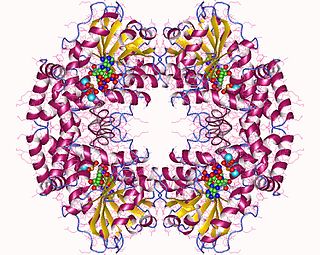
Nicotinamide adenine dinucleotide phosphate, abbreviated NADP+ or, in older notation, TPN (triphosphopyridine nucleotide), is a cofactor used in anabolic reactions, such as the Calvin cycle and lipid and nucleic acid syntheses, which require NADPH as a reducing agent ('hydrogen source'). NADPH is the reduced form of NADP+, the oxidized form. NADP+ is used by all forms of cellular life.

Malate dehydrogenase (EC 1.1.1.37) (MDH) is an enzyme that reversibly catalyzes the oxidation of malate to oxaloacetate using the reduction of NAD+ to NADH. This reaction is part of many metabolic pathways, including the citric acid cycle. Other malate dehydrogenases, which have other EC numbers and catalyze other reactions oxidizing malate, have qualified names like malate dehydrogenase (NADP+).

In enzymology, a (R,R)-butanediol dehydrogenase (EC 1.1.1.4) is an enzyme that catalyzes the chemical reaction

In enzymology, a ketol-acid reductoisomerase (EC 1.1.1.86) is an enzyme that catalyzes the chemical reaction

In enzymology, a 3-hydroxyacyl-CoA dehydrogenase (EC 1.1.1.35) is an enzyme that catalyzes the chemical reaction
In enzymology, 3-hydroxybutyrate dehydrogenase (EC 1.1.1.30) is an enzyme that catalyzes the chemical reaction:
In enzymology, a (R)-2-hydroxyacid dehydrogenase (EC 1.1.1.272) is an enzyme that catalyzes the chemical reaction
In enzymology, a (S,S)-butanediol dehydrogenase (EC 1.1.1.76) is an enzyme that catalyzes the chemical reaction
In enzymology, a 2,3-dihydro-2,3-dihydroxybenzoate dehydrogenase (EC 1.3.1.28) is an enzyme that catalyzes the chemical reaction
In enzymology, a 2,3-dihydroxy-2,3-dihydro-p-cumate dehydrogenase (EC 1.3.1.58) is an enzyme that catalyzes the chemical reaction
In enzymology, a cis-2,3-dihydrobiphenyl-2,3-diol dehydrogenase (EC 1.3.1.56) is an enzyme that catalyzes the chemical reaction

In enzymology, an aldehyde dehydrogenase (NAD+) (EC 1.2.1.3) is an enzyme that catalyzes the chemical reaction
The enzyme (2R)-sulfolactate sulfo-lyase catalyzes the reaction
Diacetyl reductase ((R)-acetoin forming) (EC 1.1.1.303, (R)-acetoin dehydrogenase) is an enzyme with systematic name (R)-acetoin:NAD+ oxidoreductase. This enzyme catalyses the following chemical reaction
(S)-sulfolactate dehydrogenase (EC 1.1.1.310, (2S)-3-sulfolactate dehydrogenase, SlcC) is an enzyme with systematic name (2S)-sulfolactate:NAD+ oxidoreductase. This enzyme catalyses the following chemical reaction

L-2-hydroxycarboxylate dehydrogenase (NAD+) (EC 1.1.1.337, (R)-sulfolactate:NAD+ oxidoreductase, L-sulfolactate dehydrogenase, (R)-sulfolactate dehydrogenase, L-2-hydroxyacid dehydrogenase (NAD+), ComC) is an enzyme with systematic name (2S)-2-hydroxycarboxylate:NAD+ oxidoreductase. This enzyme catalyses the following chemical reaction
(2R)-3-sulfolactate dehydrogenase (NADP+) (EC 1.1.1.338, (R)-sulfolactate:NADP+ oxidoreductase, L-sulfolactate dehydrogenase, (R)-sulfolactate dehydrogenase, ComC) is an enzyme with systematic name (2R)-3-sulfolactate:NADP+ oxidoreductase. This enzyme catalyses the following chemical reaction
2-Hydroxymuconate-6-semialdehyde dehydrogenase (EC 1.2.1.85, xylG [gene], praB [gene] ) is an enzyme with systematic name (2E,4Z)-2-hydroxy-6-oxohexa-2,4-dienoate:NAD+ oxidoreductase. This enzyme catalyses the following chemical reaction
3-(cis-5,6-dihydroxycyclohexa-1,3-dien-1-yl)propanoate dehydrogenase is an enzyme with systematic name 3-(cis-5,6-dihydroxycyclohexa-1,3-dien-1-yl)propanoate:NAD+ oxidoreductase. It is produced by the gene hcaB. This enzyme catalyses the following chemical reaction:
Sulfoglycolysis is a catabolic process in primary metabolism in which sulfoquinovose (6-deoxy-6-sulfonato-glucose) is metabolized to produce energy and carbon-building blocks. Sulfoglycolysis pathways occur in a wide variety of organisms, and enable key steps in the degradation of sulfoquinovosyl diacylglycerol (SQDG), a sulfolipid found in plants and cyanobacteria into sulfite and sulfate. Sulfoglycolysis converts sulfoquinovose (C6H12O8S−) into various smaller metabolizable carbon fragments such as pyruvate and dihydroxyacetone phosphate that enter central metabolism. The free energy is used to form the high-energy molecules ATP (adenosine triphosphate) and NADH (reduced nicotinamide adenine dinucleotide). Unlike glycolysis, which allows metabolism of all carbons in glucose, some sulfoglycolysis pathways convert only a fraction of the carbon content of sulfoquinovose into smaller metabolizable fragments; the remaineder is excreted as C3-sulfonates 2,3-dihydroxypropanesulfonate (DHPS) or sulfolactate (SL); or the C2-sulfonate isethionate.







